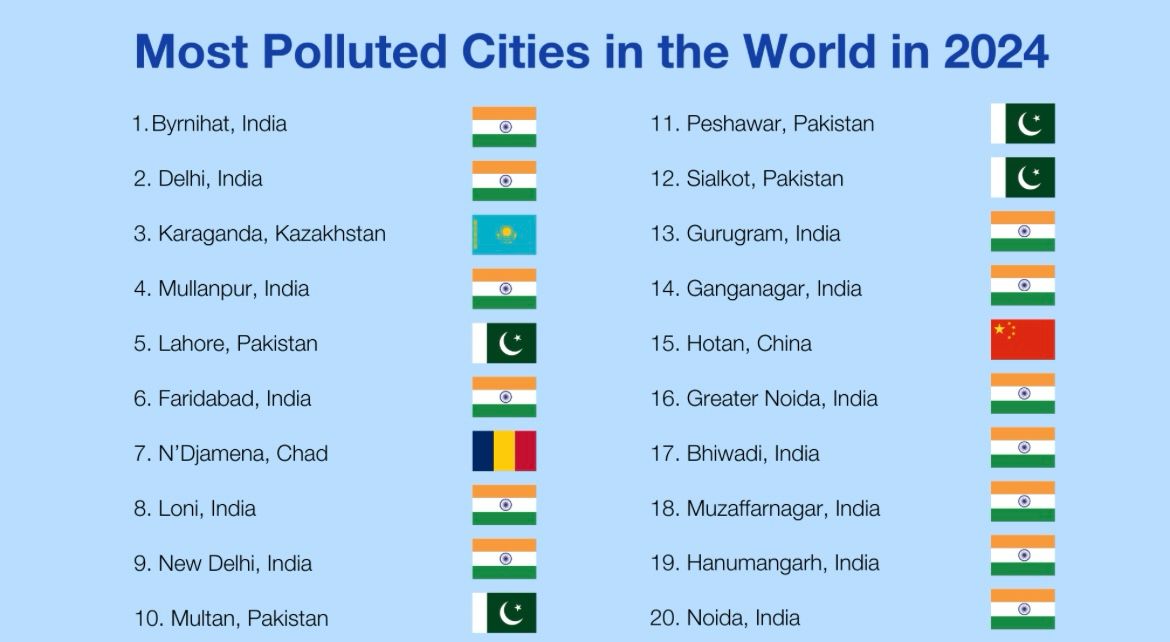Context:
Recently, The World Air Quality Report 2024, released by Swiss air quality technology company IQAir, highlights alarming levels of air pollution across the globe. It reveals that India continues to face severe pollution, with 13 of the world's 20 most polluted cities located in the country.
Key Highlights of the report:
India remains at the forefront of the global air pollution crisis, with several cities experiencing extremely high levels of harmful pollutants. The report reveals the continuing impact of rapid industrialization, agricultural practices, and vehicular emissions, which have led to deteriorating air quality across the nation.
· Delhi is the World’s Most Polluted Capital for Six Consecutive Years:
Delhi has earned the distinction of being the world’s most polluted capital for the sixth consecutive year, surpassing even other cities in the National Capital Region (NCR). The city’s annual PM2.5 concentration of 91.6 µg/m³ remains dangerously high, contributing significantly to the nation's pollution levels.
· Decline in Average PM2.5 Levels:
India showed a slight improvement in air quality in 2024, with an average PM2.5 concentration of 50.6 µg/m³, reflecting a 7% decrease from 2023 when it stood at 54.4 µg/m³. While this marks progress, the levels are still far above the WHO-recommended limit, indicating a continued need for robust measures to combat pollution.
· Most Polluted Cities in India:
Byrnihat, a city in Meghalaya, emerged as the most polluted city globally in 2024, with an annual PM2.5 concentration of 128.2 µg/m³, more than 25 times higher than the WHO recommended limit. India accounted for six of the world’s ten most polluted cities, further solidifying the country's air quality crisis.
· Major Pollution Sources:
Key contributors to pollution include crop stubble burning, which accounted for approximately 60% of the PM2.5 pollution during peak periods. Other significant sources include vehicular emissions, industrial discharges, and dust from ongoing construction projects. These sources continue to make it difficult for cities to achieve clean air standards.
Widespread Exposure to Dirty Air
The report shows that only 12 countries, regions, and territories—primarily in Latin America, the Caribbean, and Oceania—met the WHO’s annual PM2.5 guidelines. Only 17% of the 8,954 cities globally met WHO’s PM2.5 guidelines in 2024, demonstrating the widespread violations of air quality standards. The 20 most polluted cities, located primarily in India, Kazakhstan, Chad, Pakistan, and China, exceeded WHO limits by more than 10 times, highlighting a global air pollution crisis.

Most Polluted Countries
The five most polluted countries in 2024, based on annual average PM2.5 concentrations, are as follows:
- Chad: 91.8 µg/m³
- Bangladesh: 78 µg/m³
- Pakistan: 73.7 µg/m³
- Congo: 58.2 µg/m³
- India: 50.6 µg/m³
Conclusion
Air pollution is not just a problem for India; it is a widespread issue affecting the entire planet. The 2024 report highlights that a significant portion of the global population is exposed to unsafe levels of air pollution, with many countries failing to meet the World Health Organization’s (WHO) recommended PM2.5 limit of 5 µg/m³.
While some progress has been made in reducing PM2.5 levels, more urgent and comprehensive actions are required to address the root causes of pollution. Strengthening policies, improving enforcement, and investing in clean technologies will be key to mitigating the impact of air pollution on public health and the environment.







